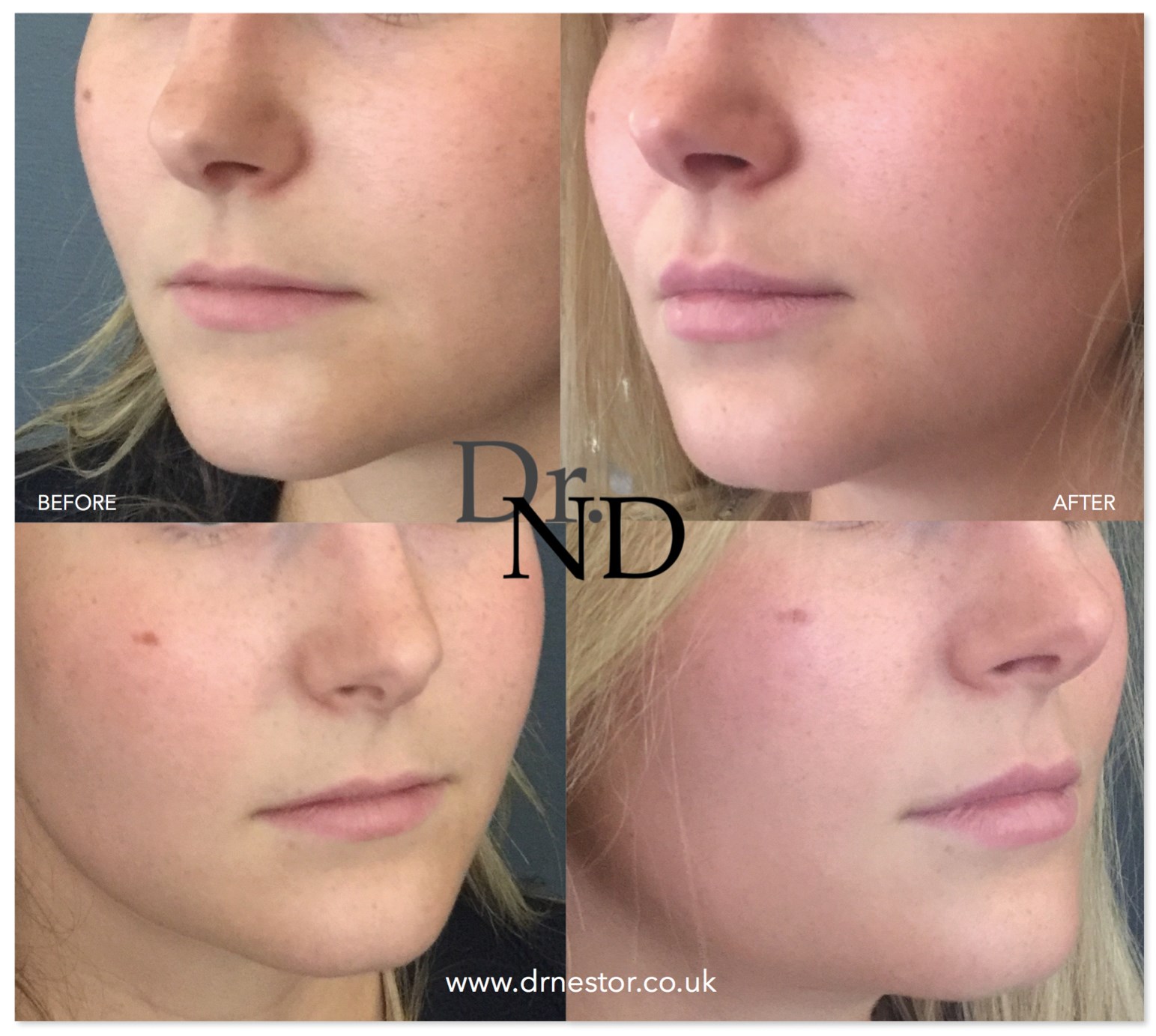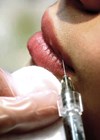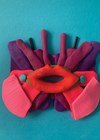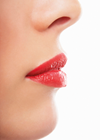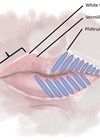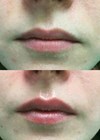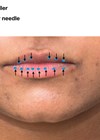In the second of our two-part special focus (see here for Part 1) on lips we are delighted to present this comprehensive clinical guide for practitioners undertaking lip augmentation.
Lips and eyes enhance facial beauty. Highlighting these has been dated back to Egyptian times where primitive forms of make-up were utilised to accentuate these features. Lip augmentation using fillers is increasingly more common and is one of the most sought after filler treatments. With celebrity endorsement and many media fuelled horror stories, it is paramount that aesthetic practitioners develop their skill and knowledge in this procedure.
Before and after photos of a patient treated with 1ml of Juvederm® Volift®.
Lip functions and anatomy
Lips are soft, movable, and serve as the opening for food intake, assist in mastication, and in the articulation of sound and speech. Human lips are a tactile sensory organ with densely packed nerve endings, and can be an erogenous zone when used in kissing.
The upper and lower lips are referred to as the ‘labium superius oris’ and ‘labium inferius oris’, respectively. The juncture where the lips meet the surrounding skin of the mouth area is the vermilion border, and the typically reddish area within the borders is called the vermilion zone. The vermilion border of the upper lip centrally is known as the Cupid’s bow. The vertical groove extending from the Cupid’s bow to the nasal septum is called the philtrum, with philtral columns on either side.
“With celebrity endorsement and many media fuelled horror stories, it is paramount that aesthetic practitioners develop their skill and knowledge in this procedure”
The skin of the lip is very thin (with three to five cellular layers), compared to typical face skin, which has up to 16 layers. The lip skin contains fewer melanocytes, therefore the blood vessels are visible through the skin of the lips, making lips appear red. The skin of the lip forms the border between the exterior skin of the face, and the interior mucous membrane of the inside of the mouth, joining at the wet dry border. It is approximately here that the labial arteries are found.
The lip skin is not hairy and does not have sweat glands. Therefore, it does not have the usual protective layer of sweat and body oils which keep the skin smooth, inhibit pathogens and regulate warmth. For these reasons, the lips dry out faster and become chapped more easily. The skin of the lips is categorised as stratified squamous epithelium, or flattened tissue cells.
The upper lip lies between the nose and the orifice of the oral cavity. Laterally the lips are separated from the cheeks by the nasolabial grooves that extend from the nose and pass approximately 1cm lateral to the angles of the mouth. The lower lip lies between the mouth and the labiomental groove, which separates the lower lip from the chin [1]. The upper and lower lips are continuous at the angles of the mouth or oral commissures.
The perfect lip
Lips are the central hallmark of the lower face and when they are full and well-defined, they impart youth, health, attractiveness and sexuality. Wider, fuller curved lips with a high vermilion and a short upper white lip are all signs of female attractiveness [2]. One of our greatest challenges is to achieve natural results after lip augmentation.
To achieve natural results it’s important to understand our underlying anatomy, and just as important to assess the lips before us accurately, so as to be able to appreciate what is and isn’t possible.
The rarely achievable ‘perfect lips’ should be curved, well-defined, with a crisp Cupid’s bow. The proportions of Phi (1:1.6) contribute greatly to the perfect lip, where the lower lip should be 1.6 times thicker than the upper lip. The lower lip should also be longer than the upper lip. Mouth corners should be at least straight and preferentially maybe slightly elevated. Again drawing from Euclid’s proportions, the distance between the nose and upper lip should represent 1 to the 1.6 of the distance from the lower lip to the chin.
Lips are of course three dimensional structures and practitioners must also look at the profile of patients when evaluating them. Steiner line is the line from the mid-nares to the chin [3]. The lips should just barely touch it. When they cross this line, the lips have been over projected. Our aim should be to achieve vertical, not anterior, projection.
An important point to check when augmenting the lips is the nasal labial angle. Armijo et al. found this should be 93.4 to 98.5 degrees for men and 95.5 to 100.1 degrees for women [4]. The concavity of the upper lip should also be assessed. There should be a ‘ski-jump’, so a slight elevation at the vermilion border of the upper lip along the whole length; this point is called the Glogau-Klein point, (point of inflection as the lip turns from glabrous skin to mucosa) avoiding ‘shelves’, ‘duck-lips’ and other nick names associated with over correction.
Asiatic lips are different from Caucasians; they have a relatively fuller upper lip, but when thinking about beauty, the lower lip should be a little bit thicker. Far fewer male patients attend for lip augmentation, although it is becoming more common. Males actually have thinner lips than females and Caucasian males have the thinnest lips. Thin lips are actually considered masculine and males with fuller lips will look a little more feminine. There are some men attending clinic for lip augmentation and practitioners must have a specific treatment plan for them as opposed to just performing the same procedure as would be done on a female patient.
Through ageing lips become thin and lose their curves. The upper lip becomes flat and elongated and actually obscures the maxillary teeth, which is very important for the smile. Radial static lip lines or ‘smoker’s lines’ become evident as a result of loss of skin elasticity and subcutaneous tissue. This is seen less in men due to thick hair follicles which help keep the skin firm. There is also loss of lip definition. The lower lip will become shorter than the upper lip, and the lower lip and chin area lose height. The proportions of Phi are therefore distorted and a 1:1 ratio of upper to lower is seen.
“I try to explain that a 1ml syringe of filler will not make their lips twice the size of a 0.5ml, but that a 1ml filler will afford me more opportunity to address size, shape and border, and ask them to think of filler as a tool to achieve better lips”
Assessment and technique
Patients attending for lip fillers have their own specific concerns. Some are worried about a ‘thin top lip’, others purely want their lips bigger. Older patients may wish to restore the volume that has been lost. It is vital to take into consideration the patient’s wishes, and assess not only their lips, but the entirety of both the peri-oral area and full face.
At the consultation it is important to advise what is appropriate and achievable for the patient’s lips, and what is not. Only when both practitioner and patient are happy to proceed should treatment be carried out.
When assessing a patient’s lips, I personally sit next to the patient, with both of us looking into the mirror and explain which features fillers can and cannot address. Areas discussed include defining the vermilion border, Cupid’s bow and philtral columns, volumising the lips a little centrally and laterally above and centrally below, as well as everting the corners of the mouth superiorly to achieve a fuller lip. In patients with mandibular retrognathia, chin augmentation is discussed as this will impact what and how much can be achieved in the lips. A patient’s dentition must also be taken into consideration, as over- or under-bite will impact on Steiner’s line.
Techniques and product
Once the patient’s lips have been thoroughly assessed from all angles, the practitioner needs to make a treatment plan. There are several documented techniques for lip procedures. It is important for the practitioner to develop different techniques and be comfortable using different fillers so as to use an appropriate methodology and product, depending on the lips before them.
The product can be a soft or medium thickness hyaluronic acid filler. My personal preferences are Juvéderm® VOLIFT® or ULTRA 3®, and Belotero Balance® or Intense®.
Border definition
Retrograde linear injections along, or just below, the vermilion border will help give a sharp border and help to slightly evert lips. Careful attention and respect must be given to the Cupid’s bow, as losing this will negate the essence of the top lip. Give a 0.05ml retrograde linear injection along each column, entering at the apex of the Cupid’s bow, with a small bolus deposited just before withdrawing the needle (Note: pinch the column while doing this).
Volume
Once again linear, retrograde injections into the vermilion, this time 2-3mm parallel to the border, can help volumise lips. Another technique is bolus injections anterior to the wet dry border, entering percutaneously from above or below the vermilion border (above for top lip, below for lower lip). This is then gently massaged to smooth out the product. Aspiration should be incorporated with this technique to avoid depositing filler intravascularly, as the arterial blood supply runs along the wet dry border. This technique is very valuable when trying to evert inverted lips laterally. Two to three such injections from the corner of the mouth, roughly 5mm apart, will give a mild, but noticeable result.
The lower lip should be given the same attention to detail as the top lip. It has protuberances and areas of higher and lower levels. The mid point is our apex and should be everted slightly. Percutaneous bolus injections into the protuberances can help give structure to the lower lip.
Lastly the corners of the mouth should be attended to. A small bolus below these of 0.05ml of filler can help to give support and turn the corners up or at least make them straight.
After the procedure lips are gently massaged for two reasons: 1. To assess capillary refill throughout; and 2. To ensure there are no lumps of filler present.
Outcomes and risks post treatment
During the consultation, aside from discussing the aims of treatment, and as part of the consent process, practitioners need to discuss the associated risks to treatment. These include swelling, either transient (less than 24 hours) or more sustained (three to five days), bruising, infection and necrosis. Should there be a concern of necrosis during the procedure, the measures that would be taken should be explained and patients are consented for the use of hyaluronidase.
Furthermore, it is vital to have a discussion of what is realistically achievable with the amount of filler patients wish to have. I explain that a 0.5ml syringe of filler will help with shape but do little for the size. I try to explain that a 1ml syringe of filler will not make their lips twice the size of a 0.5ml, but that a 1ml filler will afford me more opportunity to address size, shape and border, and ask them to think of filler as a tool to achieve better lips.
Post treatment instructions include applying only petroleum jelly to lips and to avoid lip balms and make-up. I instruct patients to avoid massaging their lips in the first week as any lumps are likely to be a result of underlying swelling. Furthermore, I give them strict instructions to avoid intensities of heat or cold for a week. Patients are always given written post treatment instructions, details of the product used, and contact information. They are urged to get in touch if there are any concerns at all. A two-week follow-up appointment is made for every patient.
Conclusion
With an ever growing demand for lip fillers the modern practitioner must learn to assess, diagnose and formulate a treatment plan specific to each set of lips. They must hone and develop different skills to treat a plethora of lip imperfections, striving to make lips better, in a very natural way. There should be little hesitance in saying ‘no’ when unrealistic and unnatural results are requested of them. With an abundance of fillers on the market, the appropriate filler should be used, depending on the treatment aim: to volumise, to rejuvenate, to hydrate, etc. The correct products are the ones that work best in each practitioner’s hands.
References
1. Moore KL, Dalley AF. Clinically Oriented Anatomy. 4th Edition. Philadelphia, USA; Lippincott Williams & Wilkins: 1999.
2. Verner I. Lip Augmentation. Body Language 2015. www.bodylanguage.net/lip-augmentation
3. Su YY, Wang CL, Liu DX, et al. Influence of chin prominence on anteriorposterior lip positions of facial profile. Shanghai Kou Qiang Yi Xue 2008;17(6):598-602.
4. Armijo BS, Brown M, Guyuron B. Defining the ideal nasolabial angle. Plast Reconstr Surg 2012;129(3):759-64.
Further reading
1. Dayan SH, Bassichis BA. Facial dermal fillers: selection of appropriate products and techniques. Aesthet Surg J 2008;28(3):335-47.
2. Vedamurthy M, Vedamurthy A. Dermal fillers: tips to achieve successful outcomes. J Cutan Aesthet Surg 2008;1(2):64-7.
3. Luthra A. Shaping lips with fillers. J Cutan Aesthet Surg 2015;8(3):139-42.
Declaration of competing interests: None declared.
COMMENTS ARE WELCOME

